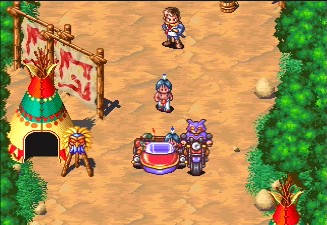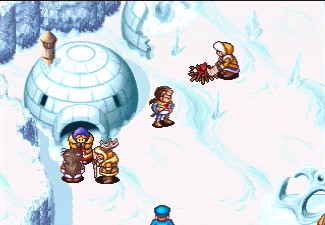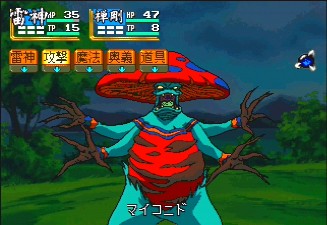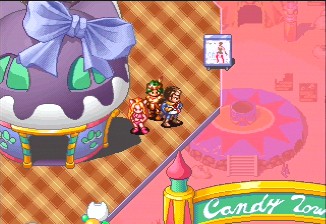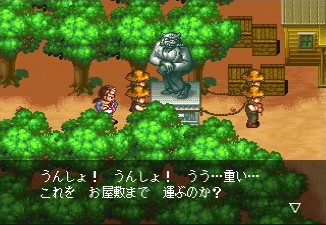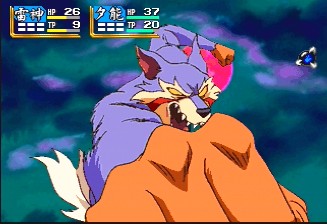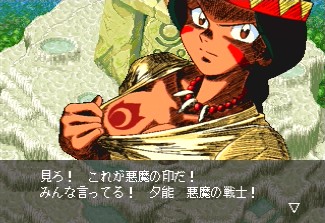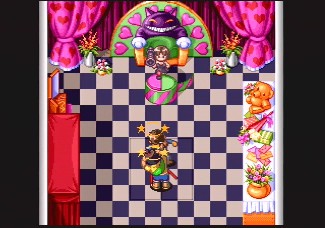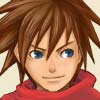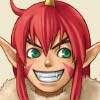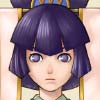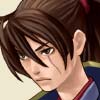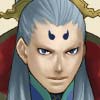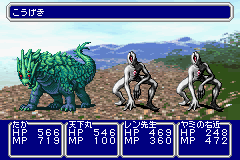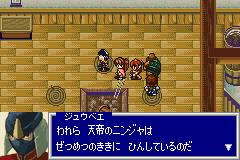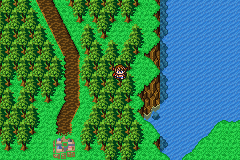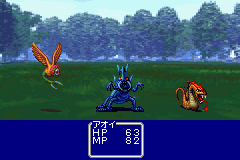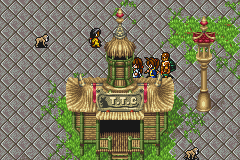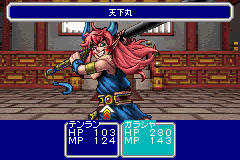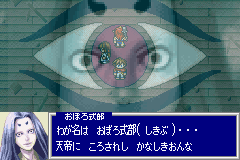
Tengai Makyō - Far East of Eden
|
Page 1: |
Page 2: |
Page 3: |
Page 4: |
|
Taking a departure from ancient Japan, Tengai Makyō: The Apocalypse IV takes you to somewhere drastically innovative for an RPG - 1890s America. And not the America we're used to reading about in history textbooks, a drastically skewed version of this beloved country, full of ridiculous misinterpretations, wacky anachronisms and more political incorrectness than you could even possibly imagine. (This same theme was used in the severely underrated PlayStation 2 RPG Shadow Hearts: From the New World.) The hero this time around is a young lad named Rizing, training under the Indian hero Red Bear. After his master is killed in the brutal ice fields of Alaska, Red Bear tells Rizing that he bears the mark of the Flame Hero, and must save America from a whole crew of denizens waiting to unleash the powers of Hell upon the land. You begin on mainland America in Portland, among the Native Americans, and it just gets wackier from there. Throughout the game, you get to visit Hollywood, escape from Alcatraz, stop a villain from carving his face onto Rushmore and ride a gigantic sacred buffalo through ice mountains. It's all spectacularly weird, visiting a town in an RPG named San Francisco or wandering through a dungeon based on Carlsbad Cavern. Naturally, all of it is terribly, terribly inaccurate, although I'd imagine it wouldn't be too hilarious to someone unfamiliar with American geography:
Just like all of the other Tengai Makyō games, this is one is filled with ridicilous characters and hilarious writing. When you come across your first Native American tribe, the chief proclaims very loudly, in the Japanese equivalent of the stereotypical "me Indian you friend" speech you see in old Westerns, that all animals are his friends, then proceeds to get mauled to pieces by a friendly looking dog. And that's not the half of it. Here the characters you get to play as:
Characters
Rizing
The hero. His name is kind of a pun - the kanji, "Raijin", means "thunder god". Is entirely straightfaced in face of all of the insanity that occurs around him.
Yumemi
Rizing's childhood friend from his early days in New Orleans, whom he meets again after a long time. But how is she connected to the demons that are popping up over the country?
Zengo
When you first meet this swordman from Jipang, he comes flying through the wall, proclaiming he was engaged in a battle with scores of men. Later, you have to strip down to your skivvies and wash his back to get him to join your party. He's a coward, a blundering idiot, and the most hilarious member of your band of heroes.
Youno
A fierce Indian maiden who fears herself a warrior of the devil, but actually bears the same seal as Rizing.
But where the game really takes off are the villains:
And that's only half of them. Particularly fun is Candy, a singer that looks like a cabaret star and who attempts to seduce the youth of Seattle with terrible pop music. She also has a henchman werewolf named Low Dog who rides a motorcycle named. Tengai fans will be pleased to see that Manto is back, and this time not only does he wear a suit, but he stars in a series of black and white movies, and he's the ruler of Lake Tahoe. Good for him.
With all of this craziness, it comes as a slight disappointment that this title doesn't really play any differently than its predecessors. There's a lot of dialogue, with gigantic portraits, along with a handful of animated cutscenes. The music is composed by one of the same guys who did Tengai Makyō Zero, and while it doesn't quite match up to that level of excellence, there's still a wide variety of themes, even if some of the techno battle pieces are a bit bland. The graphics are obviously gorgeous compared to its PC Engine and Super Famicom predecessors, but the biggest change are the battle sequences. You can actually see enemies on the map, and chose to avoid them if you can. The actual fighting is completely first person, as the enemies take up almost the entire screen, and animate fairly well. When they attack, they literally strike right at you - it's pretty cool. Some of your characters' attacks are even displayed in full motion video. Alas, it's rare that you fight more than two enemies at a time, and it's still not only rather simplistic, but also slow moving. Still, it takes a backseat to all of the incredulous activity in the game's story - you keep playing just to see what sort of absurd situation you'll find yourself in. This is, hands down, one of the most inventive and innovative RPGs ever made, and one of the best reasons to start importing Saturn games. A PSP port was also released in 2006. Unlike most PSP ports, which scale the resolution to fit the PSP screen, blurring it in the process, the developers zoomed out the display, so the pixels are in the same ratio, but you can see more of the field.
Quick Info:
|
Developer: |
|
|
Publisher: |
|
|
Director: |
|
|
Genre: |
|
|
Themes: |
Tengai Makyō: The Apocalypse IV (Saturn)
Tengai Makyō: The Apocalypse IV (Saturn)
Tengai Makyō: The Apocalypse IV (Saturn)
Tengai Makyō: The Apocalypse IV (Saturn)
Tengai Makyō: The Apocalypse IV (Saturn)
Tengai Makyō: The Apocalypse IV (Saturn)
Tengai Makyō: The Apocalypse IV (Saturn)
Tengai Makyō: The Apocalypse IV (Saturn)
Tengai Makyō: The Apocalypse IV (Saturn)
Tengai Makyō: The Apocalypse IV (Saturn)
Oriental Blue for the Gameboy Advance is so far off from the previous games that you would'nt even think it were a Tengai Makyō game, if it weren't for the fact that it was designed by Red. While it still starts off in ancient Japan, Oriental Blue plays it entirely straight, even abandoning the bright anime character designs for a more serious look. Despite the drastic change in tone, once you play the game, it's pretty clear this is a successor to the series - the first person battle system is pretty much exactly like Tengai Makyō II.
Characters
The game opens with you choosing a male or female protagonist, who begin to have visions of a girl who warns of monsters. Naturally, it's up to you to stop them. Oriental Blue features what the developers call a "free scenario system", where the storyline can be influenced by your actions - in addition to expanding upon a plethora of subquests, the plot can change depending on whether you defeat certain bosses, and different characters (over ten in total) will join depending on your main character. Your adventure takes you to Shanghai, Mongolia, Thailand and all around the land of the old orient. While the somewhat non-linear system is a great idea, it still maintains the molasses pace of the older games, without maintaining much of the old goofy joy.
Links:
Official homepage by Nintendo Japan.
Quick Info:
|
Developer: |
|
|
Publisher: |
|
|
Director: |
|
|
Designer: |
|
|
Genre: |
|
|
Themes: |
Oriental Blue (Game Boy Advance)
Oriental Blue (Game Boy Advance)
Oriental Blue (Game Boy Advance)
Oriental Blue (Game Boy Advance)
Oriental Blue (Game Boy Advance)
Oriental Blue (Game Boy Advance)
Oriental Blue (Game Boy Advance)
|
Page 1: |
Page 2: |
Page 3: |
Page 4: |
|













